
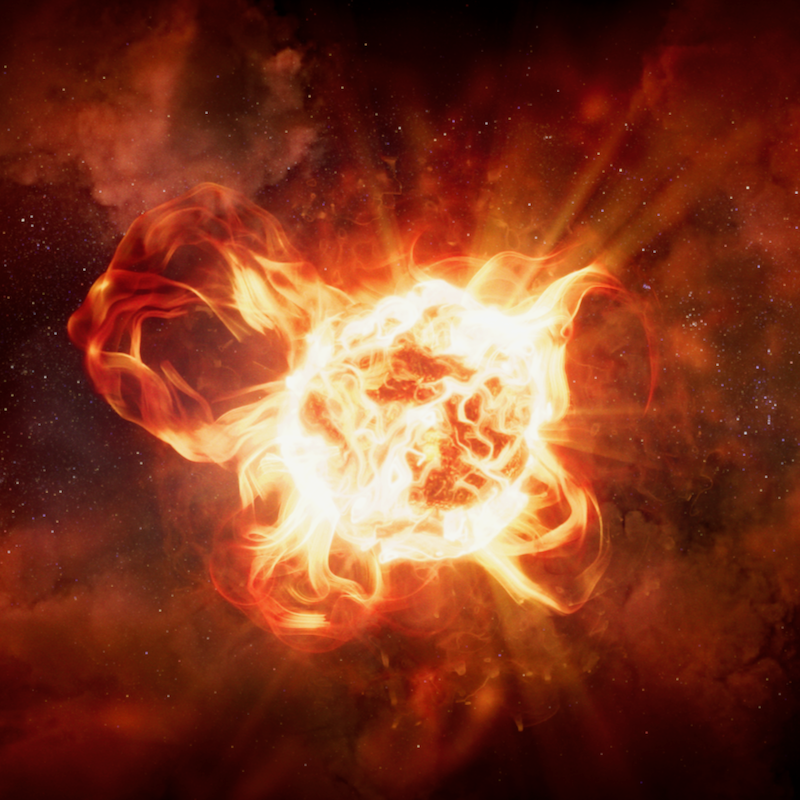
View larger. | Artist’s concept of red hypergiant VY Canis Majoris, with its giant arcs of plasma (reminiscent of prominences on our own sun). According to a new study, these vast arcs are thought to contribute to an observed dimming of this star over the past several centuries. Image via NASA/ ESA/ R. Humphreys (University of Minnesota)/ J. Olmsted (STScI)/ Hubblesite.
VY Canis Majoris – in the direction to our constellation Canis Major the Greater Dog – is one of the largest stars known. It’s a red hypergiant. It’s so huge it makes the giant star Betelgeuse look small by comparison. If you replaced our sun with VY Canis Majoris, its outer layers would extend past the orbit of the 6th planet, Saturn. It’s far away at about 3,900 light-years, so it only looks like a faint star to us (with telescopes) even though it’s actually as bright as 300,000 suns. Astronomers have wondered about this star, because – like Betelgeuse in late 2019 and early 2020 – it’s known to have faded in brightness. VY Canis Majoris, though, has faded very gradually, over the past couple of hundred years. On March 4, 2021, astronomers using the Hubble Space Telescope said they think they know why. They said this aging star is belching out huge clouds of dust, which are gradually blocking more and more its light. One of the researchers commented:
VY Canis Majoris is behaving a lot like Betelgeuse on steroids.
The researchers published their peer-reviewed findings on February 4 in The Astronomical Journal.
The dimming is reminiscent of Betelgeuse, a red supergiant star, which suddenly and dramatically faded last year, but then fully recovered its former brightness. The dimming led to speculation that Betelgeuse might explode soon in a supernova! Of course, Betelgeuse has not exploded. According to astrophysicist Roberta Humphreys at the University of Minnesota, Minneapolis – who led the new study – the dimming of VY Canis Majoris is likely similar to that of Betelgeuse, but on a much larger scale. The fading periods on VY Canis Majoris are much longer, and the star dims more dramatically.
The scientists think that there are similar processes creating the dust around both stars, but that a much larger amount of dust is being expelled by VY Canis Majoris. Dust that temporarily blocks light from the star. Humphreys commented:
This star is absolutely amazing. It’s one of the largest stars that we know of, a very evolved, red supergiant. It has had multiple, giant eruptions.

This view “zooms into” VY Canis Majoris, which is surrounded by an immense nebula of material expelled from the star. mage via NASA/ ESA/ R. Humphreys (University of Minnesota)/ J. Olmsted (STScI)/ Hubblesite.
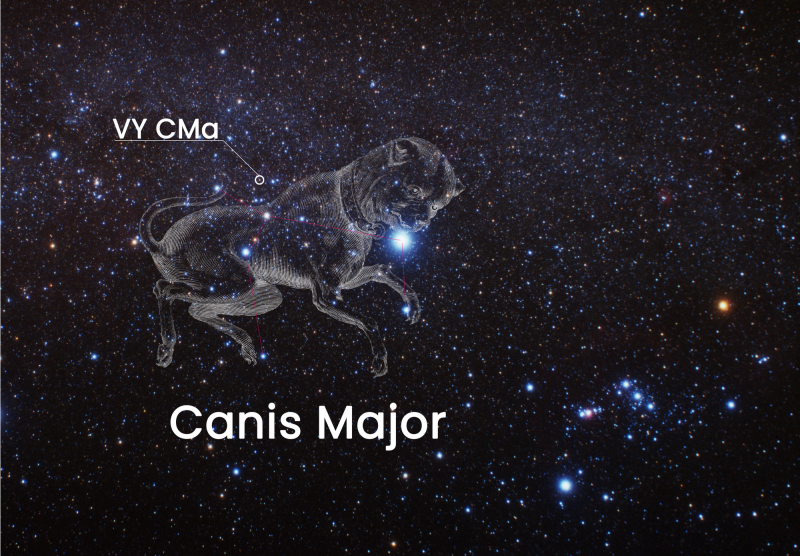
VY Canis Majoris is located in the direction to our constellation Canis Major the Greater Dog. Sirius, the brightest star in our sky, is also in this constellation. Image via NASA/ ESA/ J. DePasquale (STScI)/ A. Fujii/ Hubblesite.
So just how do these stars – Betelgeuse and VY Canis Major – emit their vast clouds of obscuring dust?
They’re thought to shed some of their mass through giant arcs of plasma, similar to the solar prominences seen to loop up at times from our own sun. The arcs from VY Canis Major – a much larger star than our sun – are also much, much larger. Another difference is that the arcs of material appear to not be physically attached to the star. Instead, they appear to be thrown out from the star, after which they drift away from it. Previously, Humphreys and her team had calculated the arcs of material had been ejected from the star in periodic episodes ranging from several hundred years ago to within the past couple hundred years.
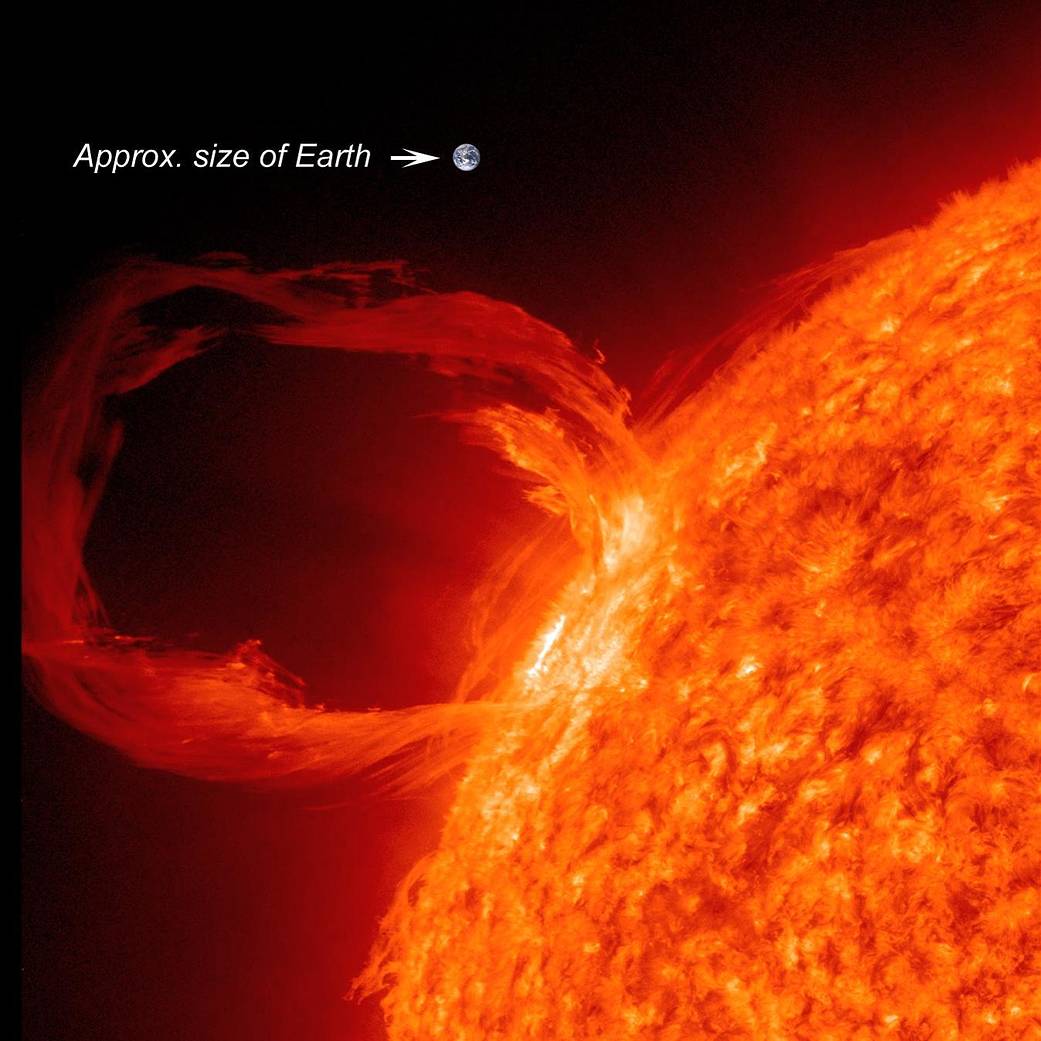
Our sun behaves in a way that’s similar to VY Canis Majoris, albeit on a smaller scale. Here’s an eruptive prominence as seen in extreme UV light on our sun, on March 30, 2010. Earth is superimposed for a sense of scale. Image via NASA/ SDO.
The new Hubble observations show additional structures, such as knots of hot gas, thought to be less than 100 years old. It turned out that the timing of the formation of some of these features coincided with observations from the 19th and 20th centuries that showed VY Canis Majoris had dimmed to about one-sixth of its usual brightness.
This is why VY Canis Major – once a visible star to the eye – can no longer be seen with the eye alone. In our time, you need a telescope to observe it.
It’s hard to fathom just how immense a red hypergiant stars like VY Canis Majoris is. The masses of just some of the small knots of gas on VY Canis Majoris are more than twice that of Jupiter. The star itself has a mind-boggling radius 1,420 times that of our sun. Betelgeuse is also immensely larger than our sun, yet VY Canis Majoris is so huge it sheds 100 times more mass than Betelgeuse. As Humphreys noted:
It’s amazing the star can do it. The origin of these high mass-loss episodes in both VY Canis Majoris and Betelgeuse is probably caused by large-scale surface activity, large convective cells like on the sun. But on VY Canis Majoris, the cells may be as large as the whole sun or larger.
This is probably more common in red supergiants than scientists thought and VY Canis Majoris is an extreme example. It may even be the main mechanism that’s driving the mass loss, which has always been a bit of a mystery for red supergiants.

The new study was led by astrophysicist Roberta Humphreys at the University of Minnesota. Image via University of Minnesota.
Giant stars like VY Canis Majoris don’t live as long as less massive stars like our sun. Our sun is already four-and-a-half billion years old and considered middle aged. VY Canis Majoris is less than 10 million years old and considered to be in its “old age.” The red hypergiant giant phase of a star like this one is estimated to last between 100,000 and 500,000 years. VY Canis Major is predicted to explode as a supernova within the next 100,000 years. If it did explode, we would see it brighten! Its distance from us (3,900 light-years) is greater than that of Betelgeuse, by the way. Betelgeuse is only about 640 light-years away.
While scientists generally think that VY Canis Majoris will eventually explode in a supernova, there’s also a chance it may also turn into a black hole instead.
It’ll be interesting to see how much dimmer the star becomes in the years ahead!
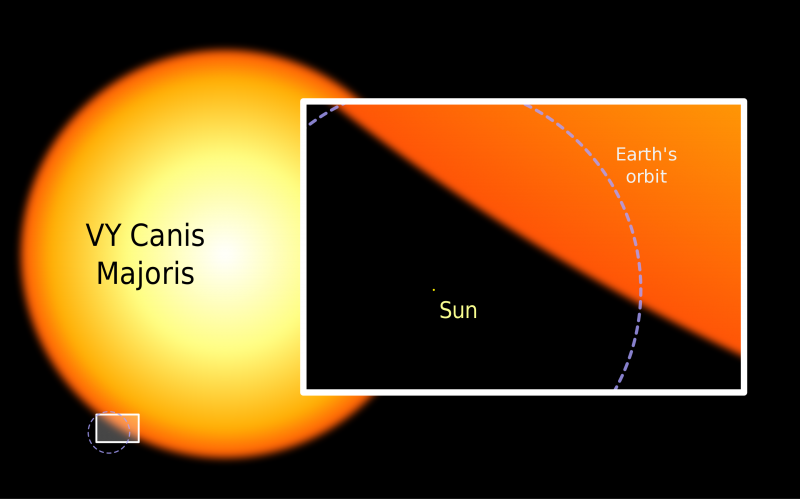
The size of VY Canis Majoris is truly immense, about 1,420 times larger (and 300,000 times brighter) than our sun. Image via Oona Räisänen/ Wikipedia.
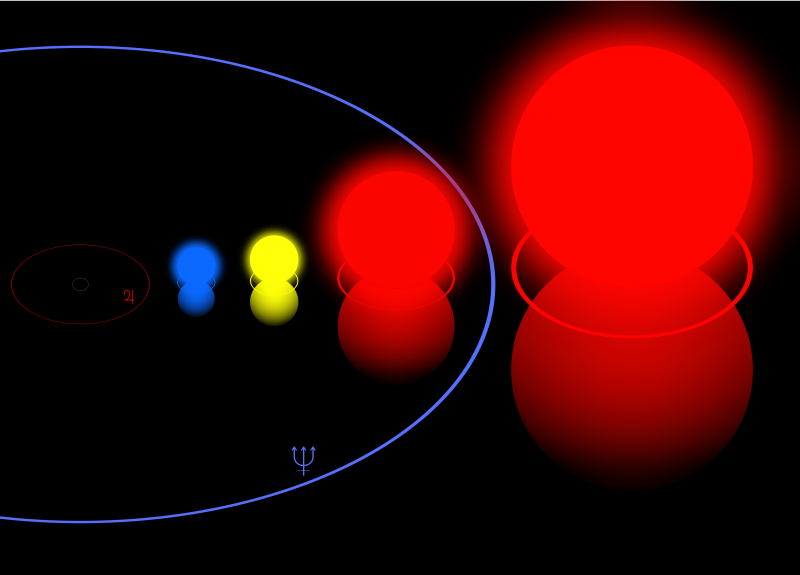
Size comparisons, from left to right, of Pistol Star, Rho Cassiopeiae, Betelgeuse and VY Canis Majoris. The orbits of Earth (gray), Jupiter (red) and Neptune (blue) are shown to scale. The sun is only an extremely tiny dot as seen here. Image via Anynobody/ Henry Mühlpfordt/ Wikipedia (CC BY-SA 3.0).
Bottom line: Astronomers think they’ve figured out why VY Canis Majoris, one of the largest and brightest stars in our galaxy, has been gradually dimming in brightness over the past couple hundred years.
Source: The Mass-loss History of the Red Hypergiant VY CMa*
from EarthSky https://ift.tt/38kftVv


View larger. | Artist’s concept of red hypergiant VY Canis Majoris, with its giant arcs of plasma (reminiscent of prominences on our own sun). According to a new study, these vast arcs are thought to contribute to an observed dimming of this star over the past several centuries. Image via NASA/ ESA/ R. Humphreys (University of Minnesota)/ J. Olmsted (STScI)/ Hubblesite.
VY Canis Majoris – in the direction to our constellation Canis Major the Greater Dog – is one of the largest stars known. It’s a red hypergiant. It’s so huge it makes the giant star Betelgeuse look small by comparison. If you replaced our sun with VY Canis Majoris, its outer layers would extend past the orbit of the 6th planet, Saturn. It’s far away at about 3,900 light-years, so it only looks like a faint star to us (with telescopes) even though it’s actually as bright as 300,000 suns. Astronomers have wondered about this star, because – like Betelgeuse in late 2019 and early 2020 – it’s known to have faded in brightness. VY Canis Majoris, though, has faded very gradually, over the past couple of hundred years. On March 4, 2021, astronomers using the Hubble Space Telescope said they think they know why. They said this aging star is belching out huge clouds of dust, which are gradually blocking more and more its light. One of the researchers commented:
VY Canis Majoris is behaving a lot like Betelgeuse on steroids.
The researchers published their peer-reviewed findings on February 4 in The Astronomical Journal.
The dimming is reminiscent of Betelgeuse, a red supergiant star, which suddenly and dramatically faded last year, but then fully recovered its former brightness. The dimming led to speculation that Betelgeuse might explode soon in a supernova! Of course, Betelgeuse has not exploded. According to astrophysicist Roberta Humphreys at the University of Minnesota, Minneapolis – who led the new study – the dimming of VY Canis Majoris is likely similar to that of Betelgeuse, but on a much larger scale. The fading periods on VY Canis Majoris are much longer, and the star dims more dramatically.
The scientists think that there are similar processes creating the dust around both stars, but that a much larger amount of dust is being expelled by VY Canis Majoris. Dust that temporarily blocks light from the star. Humphreys commented:
This star is absolutely amazing. It’s one of the largest stars that we know of, a very evolved, red supergiant. It has had multiple, giant eruptions.

This view “zooms into” VY Canis Majoris, which is surrounded by an immense nebula of material expelled from the star. mage via NASA/ ESA/ R. Humphreys (University of Minnesota)/ J. Olmsted (STScI)/ Hubblesite.

VY Canis Majoris is located in the direction to our constellation Canis Major the Greater Dog. Sirius, the brightest star in our sky, is also in this constellation. Image via NASA/ ESA/ J. DePasquale (STScI)/ A. Fujii/ Hubblesite.
So just how do these stars – Betelgeuse and VY Canis Major – emit their vast clouds of obscuring dust?
They’re thought to shed some of their mass through giant arcs of plasma, similar to the solar prominences seen to loop up at times from our own sun. The arcs from VY Canis Major – a much larger star than our sun – are also much, much larger. Another difference is that the arcs of material appear to not be physically attached to the star. Instead, they appear to be thrown out from the star, after which they drift away from it. Previously, Humphreys and her team had calculated the arcs of material had been ejected from the star in periodic episodes ranging from several hundred years ago to within the past couple hundred years.

Our sun behaves in a way that’s similar to VY Canis Majoris, albeit on a smaller scale. Here’s an eruptive prominence as seen in extreme UV light on our sun, on March 30, 2010. Earth is superimposed for a sense of scale. Image via NASA/ SDO.
The new Hubble observations show additional structures, such as knots of hot gas, thought to be less than 100 years old. It turned out that the timing of the formation of some of these features coincided with observations from the 19th and 20th centuries that showed VY Canis Majoris had dimmed to about one-sixth of its usual brightness.
This is why VY Canis Major – once a visible star to the eye – can no longer be seen with the eye alone. In our time, you need a telescope to observe it.
It’s hard to fathom just how immense a red hypergiant stars like VY Canis Majoris is. The masses of just some of the small knots of gas on VY Canis Majoris are more than twice that of Jupiter. The star itself has a mind-boggling radius 1,420 times that of our sun. Betelgeuse is also immensely larger than our sun, yet VY Canis Majoris is so huge it sheds 100 times more mass than Betelgeuse. As Humphreys noted:
It’s amazing the star can do it. The origin of these high mass-loss episodes in both VY Canis Majoris and Betelgeuse is probably caused by large-scale surface activity, large convective cells like on the sun. But on VY Canis Majoris, the cells may be as large as the whole sun or larger.
This is probably more common in red supergiants than scientists thought and VY Canis Majoris is an extreme example. It may even be the main mechanism that’s driving the mass loss, which has always been a bit of a mystery for red supergiants.

The new study was led by astrophysicist Roberta Humphreys at the University of Minnesota. Image via University of Minnesota.
Giant stars like VY Canis Majoris don’t live as long as less massive stars like our sun. Our sun is already four-and-a-half billion years old and considered middle aged. VY Canis Majoris is less than 10 million years old and considered to be in its “old age.” The red hypergiant giant phase of a star like this one is estimated to last between 100,000 and 500,000 years. VY Canis Major is predicted to explode as a supernova within the next 100,000 years. If it did explode, we would see it brighten! Its distance from us (3,900 light-years) is greater than that of Betelgeuse, by the way. Betelgeuse is only about 640 light-years away.
While scientists generally think that VY Canis Majoris will eventually explode in a supernova, there’s also a chance it may also turn into a black hole instead.
It’ll be interesting to see how much dimmer the star becomes in the years ahead!

The size of VY Canis Majoris is truly immense, about 1,420 times larger (and 300,000 times brighter) than our sun. Image via Oona Räisänen/ Wikipedia.

Size comparisons, from left to right, of Pistol Star, Rho Cassiopeiae, Betelgeuse and VY Canis Majoris. The orbits of Earth (gray), Jupiter (red) and Neptune (blue) are shown to scale. The sun is only an extremely tiny dot as seen here. Image via Anynobody/ Henry Mühlpfordt/ Wikipedia (CC BY-SA 3.0).
Bottom line: Astronomers think they’ve figured out why VY Canis Majoris, one of the largest and brightest stars in our galaxy, has been gradually dimming in brightness over the past couple hundred years.
Source: The Mass-loss History of the Red Hypergiant VY CMa*
from EarthSky https://ift.tt/38kftVv

Aucun commentaire:
Enregistrer un commentaire